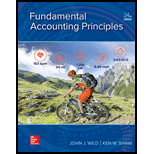
Concept explainers
Introduction:
Companies often make credit sales to earn more customers. When they sell merchandise on credit then those are classified as
Direct write off method − in direct write off method the company records the loss from uncollectible accounts and in this method they do not predict bad debts expense.
Allowance method − in this method the company makes estimate of the bad debts expense in reference to the sales made. The estimated bad debts expense is adjusted at the end of the each accounting period.
To calculate:
Santana Rey total revenues of $44,000 during the first three months of 2020 and that the Accounts Receivable balance on March 31, 2020, is $22,867. Use this information to prepare
- 1% of total revenues
- 2% of accounts receivable
Introduction:
Companies often make credit sales to earn more customers. When they sell merchandise on credit then those are classified as accounts receivable. When companies make credit sales, it expects some customers will not pay and these accounts are classified as uncollectible accounts or bad debts. Companies use two methods for the treatment of bad debts and they are direct write off method and allowance method.
Direct write off method − in direct write off method the company records the loss from uncollectible accounts and in this method they do not predict bad debts expense.
Allowance method − in this method the company makes estimate of the bad debts expense in reference to the sales made. The estimated bad debts expense is adjusted at the end of the each accounting period.
To calculate:
Santana Rey total revenues of $44,000 during the first three months of 2020 and that the Accounts Receivable balance on March 31, 2020, is $22,867. Use this information to prepare adjusting entries for bad debts if the accounts receivable balance at June 30, 2020, is $20,250 and that one account of $100 has been written off against the Allowance for Doubtful Accounts since March 31, 2020.
Introduction:
Payroll of a company consists of the wages, salaries, and employee benefits and taxes deductions. The gross pay is total compensation of an employee that includes wages, salaries and benefits without deducting any taxes. Payroll deductions include FICA social security taxed, FICA Medicare taxed, Income tax deductions and other deductions.
To calculate:
To determine whether Rey should consider using the direct write-off method of accounting or the allowance methods for his business.
Want to see the full answer?
Check out a sample textbook solution
Chapter 9 Solutions
FUND.ACCT.PRIN.(LOOSELEAF)-W/ACCESS
- What exactly are intangible assets and how are they defined? How are intangible assets different from plant assets?arrow_forwardAnswer this without using chatgtp or AIarrow_forwardNicole is a calendar-year taxpayer who accounts for her business using the cash method. On average, Nicole sends out bills for about $12,000 of her services on the first of each month. The bills are due by the end of the month, and typically 70 percent of the bills are paid on time and 98 percent are paid within 60 days. a. Suppose that Nicole is expecting a 2 percent reduction in her marginal tax rate next year. Ignoring the time value of money, estimate the tax savings for Nicole if she postpones mailing the December bills until January 1 of next year.arrow_forward

 AccountingAccountingISBN:9781337272094Author:WARREN, Carl S., Reeve, James M., Duchac, Jonathan E.Publisher:Cengage Learning,
AccountingAccountingISBN:9781337272094Author:WARREN, Carl S., Reeve, James M., Duchac, Jonathan E.Publisher:Cengage Learning, Accounting Information SystemsAccountingISBN:9781337619202Author:Hall, James A.Publisher:Cengage Learning,
Accounting Information SystemsAccountingISBN:9781337619202Author:Hall, James A.Publisher:Cengage Learning, Horngren's Cost Accounting: A Managerial Emphasis...AccountingISBN:9780134475585Author:Srikant M. Datar, Madhav V. RajanPublisher:PEARSON
Horngren's Cost Accounting: A Managerial Emphasis...AccountingISBN:9780134475585Author:Srikant M. Datar, Madhav V. RajanPublisher:PEARSON Intermediate AccountingAccountingISBN:9781259722660Author:J. David Spiceland, Mark W. Nelson, Wayne M ThomasPublisher:McGraw-Hill Education
Intermediate AccountingAccountingISBN:9781259722660Author:J. David Spiceland, Mark W. Nelson, Wayne M ThomasPublisher:McGraw-Hill Education Financial and Managerial AccountingAccountingISBN:9781259726705Author:John J Wild, Ken W. Shaw, Barbara Chiappetta Fundamental Accounting PrinciplesPublisher:McGraw-Hill Education
Financial and Managerial AccountingAccountingISBN:9781259726705Author:John J Wild, Ken W. Shaw, Barbara Chiappetta Fundamental Accounting PrinciplesPublisher:McGraw-Hill Education





